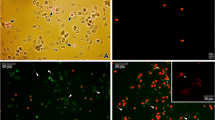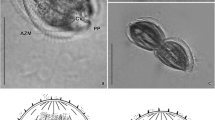Abstract
Excystation in vitro ofBucephaloides gracilescens metacercaria is a two-stage event. An initial, passive phase of peptic digestion for 1 h at pH 2 removes much of the outer, fibrous and cellular capsule of host origin. The second, active phase is triggered by a rise in environmental pH (to pH 7.2) which stimulates muscular activity in the metacercaria resulting in excystation within 5 min. Angler bile, the bile salts sodium taurocholate and sodium glycocholate, or the bile salt mixture, and sodium tauroglycocholate increase the rate and percentage of successful excystation. Cysts from the orbit and nasal regions of whiting have thicker walls than those from the auditory capsules and cranial fluid of the brain and require a longer period (2 h) of pepsin digestion for optimal excystation. Trypsin, reducing agents, or a CO2-atmosphere play no apparent role in excystation.
Similar content being viewed by others
References
Asanji MF, Williams MO (1975) Studies on the excystment of trematode metacercariae in vitro. Z Parasitenkd 47:151–163
Chakrabarti KK, Baugh SC (1974) On the Bucephalid metacercariaBucephalopsis linguiformis n. sp., from Indian freshwater fishesEsomus danricus andNemachilus botia. Neth J Zool 24:50–57
Dixon KE (1966) The physiology of excystment of the metacercaria ofFasciola hepatica L. Parasitology 56:431–456
Erasmus DA, Bennett LJ (1965) A study of some of the factors affecting excystation in vitro of the metacercarial stages ofHolostephanus luhei Szidat, 1936 andCyathocotyle bushiensis Khan, 1962 (Strigeoidea: Trematoda). J Helminthol 39:185–196
Fried B (1970) Excystation of metacercariae ofPosthodiplostomum minimum minimum Hoffman, 1958, and their development in the chick and on the chorioallantois. J Parasitol 56:944–946
Fried B, Butler MS (1978) Infectivity, excystation and development on the chick chorioallantois of the metacercaria ofEchinostoma revolutum (Trematoda). J Parasitol 64:175–177
Fried B, Robbins SH, Nelson PD (1978) In vivo and in vitro excystation ofZygocotyle lunata (Trematoda) metacercariae and histochemical observations on the cyst. J Parasitol 64:395–397
Graff DJ, Kitzman WB (1965) Factors influencing the activation of acanthocephalan cystacanths. J Parasitol 51:424–429
Halton DW (1978) Trans-tegumental absorption of L-alanine and L-leucine by a monogenean,Diclidophora merlangi. Parasitology 76:29–37
Howell MJ (1970) Excystment of the metacercariae ofEchinoparyphium serratum (Trematoda: Echinostomatidae). J Helminthol 44:35–56
Hunter WS, Chait DC (1952) Notes on excystment and culture in vitro of the microphallid trematodeGynaecotyla adunca (Linton, 1905). J Parasitol 38:87
Johnston BR, Halton DW (1981) Occurrence ofBucephaloides gracilescens metacercariae in three species of gadoid fish. J Fish Biol 19 (in press)
Lackie AM (1975) The activation of infective stages of endoparasites of vertebrates. Biol Rev 50:285–323
Macy RW, Berntzen AK Benz M (1968) In vitro excystation ofSphaeridiotrema globulus metacercariae, structure of cyst, and the relationship to host specificity. J Parasitol 54:28–38
McDaniel JS (1966) Excystment ofCryptocotyle lingua metacercariae. Biol Bull 130:369–377
Mitchell JS, Halton DW, Smyth JD (1978) Observations on the in vitro culture ofCotylurus erraticus (Trematoda: Strigeidae). Int J Parasitol 8:389–397
Pandey KC (1969)Bucephalopsis hexaglandulata sp.n.,B. oxygasteri sp.n., andB. multiglandulata sp.n.: gasterostome metacercariae from Indian fishes. Trans Am Microsc Soc 88:486–491
Rothman AH (1959) Studies on the excystment of tapeworms. Exp Parasitol 8:336–364
Smyth JD, Haslewood GAD (1963) The biochemistry of bile as a factor in determining host specificity in intestinal parasites with particular reference toEchinococcus granulosus. Ann NY Acad Sci 113:234–260
Author information
Authors and Affiliations
Rights and permissions
About this article
Cite this article
Johnston, B.R., Halton, D.W. Excystation in vitro ofBucephaloides gracilescens metacercaria (Trematoda: Bucephalidae). Z. Parasitenkd. 65, 71–78 (1981). https://doi.org/10.1007/BF00926555
Received:
Issue Date:
DOI: https://doi.org/10.1007/BF00926555




